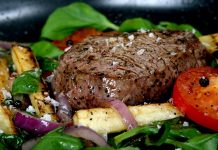August 2003 � Even after the jolt of a heart attack or bypass operation, some cardiac rehabilitation patients may "just say no" not only to obviously harmful dietary fat but also to beneficial fruits and vegetables.
These contradictory responses mean that different approaches are needed to change overall eating habits and reduce the risk of future heart problems, say C. Jeffrey Frame, Ph.D., R.D., and colleagues.
Their study of 118 patients, carried out at a cardiac rehabilitation unit in a hospital in Greensboro, N.C., appears in the July/August issue of the American Journal of Health Promotion.
Frame, an assistant professor of nutrition, dietetics and food management at Murray State University in Kentucky, and colleagues followed patients who had been prescribed cardiac rehabilitation following coronary bypass operations, heart attacks or other heart problems. They interviewed the patients at the start and end of a 12-week cardiac rehabilitation program and again two years later.
During the rehab program, a dietitian worked individually with patients to develop nutrition and weight maintenance goals. The patients attended a group education session for one hour each week. There they learned about reducing fat, salt and sugar in their diets; increasing dietary fiber and fruits and vegetables; using herbs and spices to make food taste better; methods for healthier food preparation; and recommended food choices when dining out.
Continue Reading Below ↓↓↓
The researchers evaluated each patient based on the "state-of-change" concept. This analysis includes five steps: pre-contemplation (not knowing or caring about a health risk); contemplation (knowing it, but not ready to do anything about it); preparation (getting ready to make an active effort); action (doing something positive for up to six months); maintenance (doing the right thing for more than six months and working to prevent relapse).
The sobering effect of cardiac surgery or a heart attack clearly moved many people to take action on reducing dietary fat by the start of the rehab program, Frame says. By the end of the rehab program, 81 percent were in the preparation, action or maintenance stages. Two years later, 87 percent (105 out of 118) were in the maintenance stage alone.
But these same patients, who apparently did so well cutting down fat intake, made little progress during the same time toward eating five servings of fruits and vegetables a day. After two years, only 23 percent were at the maintenance stage, while 59 percent had slid down the ladder to the pre-contemplation or contemplation stages.
"There is no evidence that movement within the stages of change for one behavior was related to movement within the stages of change for the other food behavior," Frame says.
The findings about dietary fat, while encouraging, still left Frame concerned. For one thing, similar research on fat in the general population shows that most subjects remained in the ignorant or apathetic stages. In addition, what appears to be better results in reducing fat intake may be partially due to "deliberate misrepresentations by patients to avoid criticism and gain social conformity and social approval" from doctors, dietitians, family and friends, Frame says.
The problem may be due to the notions of the two different kinds of foods that patients bring with them to the rehab program. Fat was already seen as not a heart-healthy choice.
"But many patients perceived little or no relationship between fruit and vegetable intake and cardiovascular health," says Frame.
Funding for this project was provided by the Institute of Nutrition, University of North Carolina-Chapel Hill, and by the Committee on Institutional Service and Research, Murray State University.
Source: Health Behavior News Service









